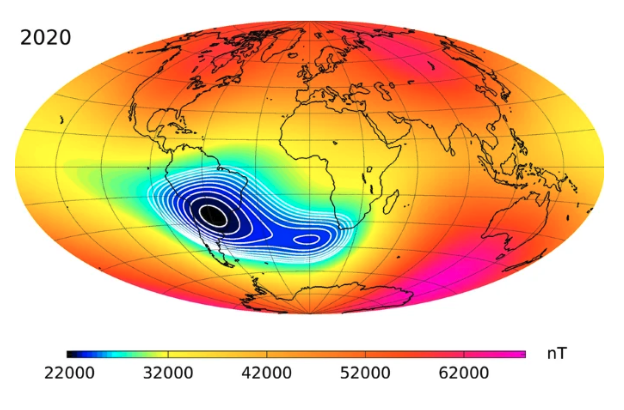South Atlantic Anomaly (SAA)
1. What is the SAA?
The South Atlantic Anomaly (SAA) is a region where the planet’s magnetic field is unusually weak relative to most other places on Earth.
In this region, the inner Van Allen radiation belt comes closer to Earth’s surface (down to about 200 km altitude) than elsewhere, which means that satellites and spacecraft passing overhead in low Earth orbit face elevated radiation exposure.
2. Why does it exist?
The Earth’s magnetic field is not perfectly centred or symmetrical — the magnetic dipole axis is offset and tilted from the Earth’s rotational axis. This causes variations in field strength at various longitudes.
Over the South Atlantic region (roughly off the coast of Brazil / South America and extending toward southwestern Africa), the magnetic field dips, or “weakens,” allowing more energetic charged particles from space to penetrate closer to Earth.
Studies suggest the anomaly has physical roots deep inside the Earth — namely, features at the core-mantle boundary (e.g., “reverse flux patches”) contributing to the dip in field strength.
3. Why should we care?
Satellite and spacecraft operations: Because radiation levels are higher in the SAA, orbital vehicles (especially those in low Earth orbit) may experience single event upsets (SEUs), instrument glitches or higher malfunction risk when passing through this region.
Navigation and communications: Instruments using magnetometers, radiation detectors or sensitive electronics can be adversely affected when traversing the SAA zone.
Earth / space weather implications: The anomaly provides insight into larger-scale changes in Earth’s magnetic field, which is a key component of how the Earth shields itself from solar and cosmic radiation. The changes in the SAA may signal changes in the geomagnetic system.
Scientific curiosity: The SAA is a visible manifestation of deeper geophysical processes (like the dynamo in Earth’s outer core) and helps scientists study how Earth’s interior works and how the magnetosphere evolves over time.
4. Recent Trends & Updates
The SAA has been observed to expand and drift. According to recent analyses, the region has grown in size since data from about 2014.
A new “lobe” or secondary minimum seems to have appeared to the southwest of Africa, indicating a possible splitting or change in structure.
Paleomagnetic studies indicate that similar anomalies in the South Atlantic region are not entirely new — evidence suggests activity 8–11 million years ago. This suggests that the SAA may be a recurring feature rather than a one-off phenomenon. =
5. Impacts & Myth vs Reality
What it does do:
For satellites in polar or low-inclination orbits, increased radiation flux means more exposure when passing through the SAA.
Some past missions have taken precautionary measures when traversing this region (e.g., turning off certain instruments) to avoid damage.
Changes in the anomaly help scientists track how Earth’s magnetic field is evolving.
What it doesn’t (currently) do:
There’s no clear evidence that the SAA is causing widespread impacts to life on Earth (surface humans, ecosystems) at present.
It is not a “portal” or “black hole” (despite sensational media analogies). The effects are real for space hardware and high-altitude systems, but not of the colossal scale sometimes portrayed.
6. Why the Anomaly Matters for the Future
As modern space infrastructure (satellites, low-Earth-orbit constellations, spacecraft) expands, regions like the SAA will be more relevant for mission planning, radiation shielding, and orbit design.
The drift and change in the anomaly may be an indicator that Earth’s magnetic field is undergoing notable change — which could have long-term implications (though not necessarily a sudden “pole reversal”).
Understanding such anomalies can help improve geomagnetic models, space weather forecasting and radiation risk mitigation — all important for both space operations and Earth-bound systems (e.g., aviation, communications).
7. Key Takeaway
The South Atlantic Anomaly is a fascinating and somewhat mysterious feature of Earth’s magnetosphere: a zone where the protective magnetic field is weaker, the radiation belt dips, and satellites feel the difference. While it doesn’t pose a dramatic immediate threat to everyday life, it has real operational importance for space-based systems and offers a window into the dynamic processes deep within our planet. As our reliance on space infrastructure grows and as the anomaly continues to evolve, keeping an eye on this geo-space “weak spot” is more than just academic — it’s practical.
You May Also Like

📰 Lenskart Stock: Strong Business, But Valuation...
💡 Company SnapshotLenskart Solutions Ltd is India’s largest organised eyewear retailer—coverin...

Maruti Suzuki Wagon R (2025 Model) — Overview & Ke...
✅ What’s New for 2025All variants now come standard with 6 airbags, a significant upgrade for...

South Atlantic Anomaly (SAA)
1. What is the SAA?The South Atlantic Anomaly (SAA) is a region where the planet’s magnetic fie...


